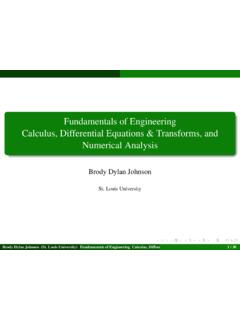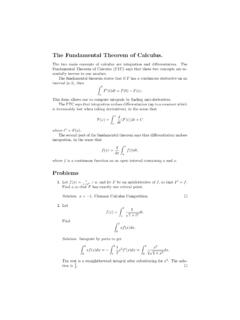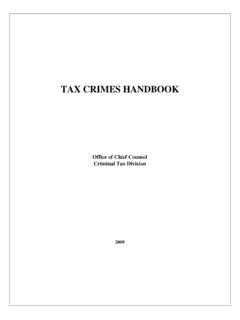Transcription of Chapter 2.2 Conditional Statements - Saint Louis University
1 DISCRETE MATH: LECTURE 3DR. DANIEL Conditional Statements Ifpandqare statement variables, theconditionalofqbypis Ifpthenq or pimpliesq and is denotedp q. It is false whenpis true andqis false ; otherwiseit is true. We callpthehypothesis(orantecedent) of the Conditional andqtheconclusion(orconsequent).pqp qTTTFFTFF A Conditional statement that is true by virtue of the fact that its hypothesis is falseis calledvacuously trueortrue by default. In general, when the if part ofan if-then statement is false , the statement as a whole is said to be true, regardlessof whether the conclusion is true or example:If 0 = 1, then 1 = 2. NOTE: Theorder of operationsfor evaluating Statements is first, then and , and finally .For example:Construct the truth table for the statementp q p qp qp q Class Group Work:Show thatp q r (p r) (q r).
2 12DR. DANIEL ofIf-ThenasOrand The Negation of a Conditional State-ment. You can writep qas p q. The negation of ifpthenq is logically equivalent to pand notq, that is, (p q) p Class Group Work:First, show thatp q p q. Then, show that (p q) p q. Finally, write down a Conditional statement and then negate MATH: LECTURE , Converse, Inverse Words that made you tremble in highschool geometry. Thecontrapositiveof a Conditional statement of the formp qis: If q p. A Conditional statement is logically equivalent to its contrapositive! (This is veryuseful for proof writing!) Theconverseofp qisq p. Theinverseofp qis p q. A Conditional statement and its converse are NOT logically equivalent. A Conditional statement and its inverse are NOT logically equivalent. The converse and the inverse of a Conditional statement are logically equivalent toeach example:Write down a Conditional statement and its contrapositive, converse,and Ifand the Biconditional.
3 Ifpandqare Statements ,ponly ifqmeans if notqthen notp, or equivalently, ifpthenq. Given statement variables,pandq, thebiconditional ofpandqis pif, andonly if, q and is denotedp q. It is true if bothpandqhave teh same truthvalues and is false ifpandqhave opposite truth values. The wordsif and only ifare sometimes abbreviatediff. The biconditional has the following truth table:pqp qTTTFFTFF The order of operations for logical operators is:(1) Evaluate first.(2) Evaluate and second. When both are present, parenthesis may be needed.(3) Evaluate and third. When both are present, parenthesis may be needed. Notice thatp qis equivalent to (p q) (q p). Class Group Work:Use a truth table to showp q (p q) (q p).4DR. DANIEL and Sufficient Conditions. Ifrandsare Statements : ris asufficient conditionforsmeans ifrthens.
4 Ris anecessary conditionforsmeans if notrthen nots. Because Statements and their contrapositives are equivalent, ris a necessary con-dition fors also means ifsthenr. Hence, ris a necessary and sufficient condition fors means rif, and only if,s. For example:If John is eligible to vote, then he is at least 18 years Valid and Invalid Arguments Anargumentis a sequence of Statements , and anargument formis a sequenceof sttement forms. All Statements in an argument and all statement forms in anargument form, except for the final one, are calledpremises(orassumptionsorhypotheses ). The final statement or statement form is called the conclusion. Thesymbol , which is read therefore, is normally placed just before the conclusion. To say that anargument formisvalidmeans that no matter what particular state-ments are substituted for the statement variables in its premises, if the resultingpremises are all true, then the conclusion is also true.
5 To say that anargumentisvalidmeans that its form is valid. A valid argument is is such that the truth of its conclusion follows necessarilyfrom the truth of its premises. It is impossible to have a valid argument with truepremises and a false conclusion. Testing an argument form for validity(1) Identify the premises and conclusion of the argument form.(2) construct a truth table showing the truth values of all the premises and theconclusion.(3) A row of the truth table in which all the premises are true is called acriticalrow. If there is a critical row in which the conclusion is false , then it is possiblefor an argument of the given form to have true premises and a false conclusion,and so the argument form is invalid. if the conclusion ineverycritical row istrue, then the argument form is example:Determine the validity of the following argument:p q rq p r p rDISCRETE MATH: LECTURE 35pqr rq rp rp q rq p rp Ponens and Modus Tollens.
6 An argument form consisting of two premises and a conclusion is called first and second premises are called themajor premiseandminor premise,respectively. Themodus ponensargument form has the following q. Modus tollenshas the following form:Ifpthenq. q example:Write down an example of modus ponens and an example of DANIEL Valid Argument Forms: Rules of Inference. Arule of inferenceis a form of argument that is valid. Modus ponens and modustollens are both rules of inference. Here are some q p q qSpecializationp q p pTransitivityp qProof by Division into Casesp qq rp q p rq rConjunctionp rqContradiction Rule p c p q Class Group famous detective Percule Hoirot was called in to solvea baffling murder mystery. He determined the following facts:(1) Lord Hazelton, the murdered man, was killed by a blow on the head with a brasscandlestick.
7 (2) Either Lady Hazelton or a maid, Sara, was in the dining room at the time of themurder.(3) If the cook was in the kitchen at the time of the murder, then the butler killed LordHazelton with a fatal dose of strychnine.(4) If Lady Hazelton was in the dining room at the time of the murder, then thechauffeur killed Lord Hazelton.(5) If the cook was not in the kitchen at the time of the murder, then Sara was not inthe dining room when the murder was committed.(6) if Sara was in the dining room at the time the murder was committed, then thewine steward killed Lord it possible for the detective to deduce the identity of the murderer from these facts? Ifso, who did murder Lord Hazelton? (Assume there was only one cause of death).DISCRETE MATH: LECTURE Afallacyis an error in reasoning hat results in an invalid argument.
8 Three com-mon fallacies areusing ambiguous premises, and treating them as if they wereunambiguous,circular reasoning(assuming what is to be proved without havingderived it from the premises), andjumping to a conclusion(without adequategrounds). For an argument to be valid, every argument of the same form whose premises areall true must have a true conclusion. It follows that for an argument to be invalidmeans that there is an argument of that form whose premises are all true and whoseconclusion is false . Here are two more error typesConverse Errorp qInverse Errorp qq p p q








